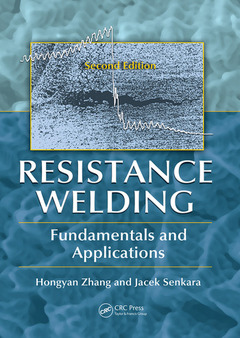Resistance Welding (2nd Ed.) Fundamentals and Applications, Second Edition
Auteurs : Zhang Hongyan, Senkara Jacek

Drawing on state-of-the-art research results, Resistance Welding: Fundamentals and Applications, Second Edition systematically presents fundamental aspects of important processes in resistance welding and discusses their implications on real-world welding applications. This updated edition describes progress made in resistance welding research and practice since the publication of the first edition.
New to the Second Edition:
- Significant addition of the metallurgical aspects of materials involved in resistance welding, such as steels, aluminum and magnesium alloys, zinc, and copper
- Electric current waveforms commonly used in resistance welding, including single-phase AC, single-phase DC, three-phase DC, and MFDC
- Magnesium welding in terms of cracking and expulsion
- The effect of individual welding parameters
- 2-D and 3-D lobe diagrams
- New materials for the ultrasonic evaluation of welds, including A-scan, B-scan, and in-line A-scan
The book begins with chapters on the metallurgical processes in resistance spot welding, the basics of welding schedule selection, and cracking in the nugget and heat-affected zone of alloys. The next several chapters discuss commonly conducted mechanical tests, the monitoring and control of a welding process, and the destructive and nondestructive evaluation of weld quality. The authors then analyze the mechanisms of expulsion?a process largely responsible for defect formation and other unwanted features?and explore an often overlooked topic in resistance welding-related research: the influence of mechanical aspects of welding machines. The final chapters explain how to numerically simulate a resistance welding process and apply statistical design and analysis approaches to welding research.
To obtain a broad understanding of this area, readers previously had to scour large quantities of research on resistance welding and essential related subjects, such as statistical analysis. This book collects the necessary information in one source for students, researchers, and practitioners in the sheet metal industry. It thoroughly reviews state-of-the-art results in resistance welding research and gives you a solid foundation for solving practical problems in a scientific and systematic manner.
Welding Metallurgy. Electrothermal Processes of Welding. Weld Discontinuities. Mechanical Testing. Resistance Welding Process Monitoring and Control. Weld Quality and Inspection. Expulsion in Resistance Spot Welding. Influence of Mechanical Characteristics of Welding Machines. Numerical Simulation in Resistance Spot Welding. Statistical Design, Analysis, and Inference in Resistance Welding Research. Index.
Dr. Hongyan Zhang is an associate professor in the Department of Mechanical, Industrial, and Manufacturing Engineering at the University of Toledo. He has published over 70 peer-reviewed journal and conference papers and contributed to a number of American Welding Society Standards. His research interests include materials, forming, welding, and mechanical fastening; manufacturing process monitoring and control; failure analysis; structural optimization; and hybrid propulsion systems.
Dr. Jacek Senkara is a professor of the Production Engineering Faculty at Warsaw University of Technology. He has published roughly 100 scientific and technical papers in professional journals and conference proceedings and served as a principal investigator for a number of government, industry, and university-supported research projects. His research interests include materials aspects of welding and welding-related processes, along with the surface modification of materials.
Date de parution : 04-2017
17.8x25.4 cm
Date de parution : 01-2012
Ouvrage de 436 p.
17.8x25.4 cm
Thèmes de Resistance Welding :
Mots-clés :
Electrode Force; Faying Interface; Electric Current Waveforms; Nugget Diameter; Ultrasonic Evaluation Of Welds; Partial Melting Zone; Mg Welding; Welding Current; Lobe Diagrams; Weld Nugget; Resistance Welding; Welding Schedules; Weld Lobes; RSW Process; Welding Time; Resistance Spot Welds; Solidi Cation; Electrode Life; Nugget Zone; DP600 Steel; Al Welding; Spot Weldment; Weld Quality; Weld Button; Nugget Size; Weld Diameter; Contact Resistance; Ta Ge; Weld Nugget Size



